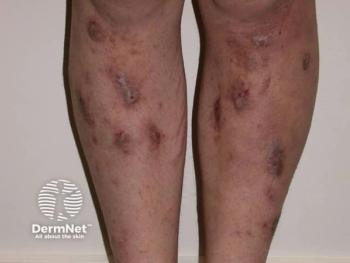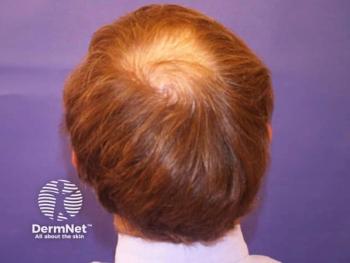
- Dermatology Times, August 2024 (Vol. 45. No. 08)
- Volume 45
- Issue 08
Neoadjuvant and Adjuvant Vismodegib for Complex Basal Cell Carcinomas
To improve overall outcomes for patients with large basal cell carcinomas, it has been beneficial to employ the use of vismodegib as a neoadjuvant and/or adjuvant treatment.
Basal cell carcinoma is a slow-growing tumor that rarely metastasizes; however, a few patients have recently presented to our hospital with rare, large basal cell carcinomas infiltrating both the skull and brain. Despite basal cell carcinoma being the most common nonmelanoma skin cancer in the United States,1 it is uncommon for a basal cell carcinoma to become so advanced that it penetrates the skull. These patients in their 60s and 70s had limited access to the hospital health care system, and some of them had to focus on caring for their loved ones rather than their own health care needs. When presented with these patients with large basal cell carcinomas, the options are limited for treatment.
Vismodegib (Erivedge; Genentech) received approval from the FDA in 2012 and has been effectively used for patients with metastatic or locally advanced basal cell carcinomas who are not eligible candidates for radiation or surgery.1 It is also approved for patients with locally advanced basal cell carcinoma that has recurred following surgery. Vismodegib is a hedgehog pathway inhibitor that binds to the smoothened protein, preventing the creation and growth of a basal cell carcinoma tumor. Although surgery is the gold standard for treatment and reducing recurrence, sometimes initially starting with surgery would lead to a higher morbidity and mortality rate. In some cases, to prevent metastases of basal cell carcinoma, vismodegib has been used as a maintenance therapy after surgery. To improve overall outcomes for patients with large basal cell carcinomas, it has been beneficial to employ the use of vismodegib as a neoadjuvant and/or adjuvant treatment.
Neoadjuvant Treatment
Depending on the location and size of the tumor, the patient may take vismodegib for several months prior to surgery to decrease the size of the tumor burden. The intention is to make the skin cancer smaller, therefore making the surgical defect also decreased in size. This can lead to a less intensive and decreased surgery for the patient. Patients are counseled that they will be on vismodegib 150 mg daily by mouth for at least several months before it is reassessed that the skin cancer is small enough to operate. However, we have had patients who responded so well to the medication that they could be on vismodegib for less time and undergo surgery sooner. In addition, there have been some patients who could not tolerate the adverse effects (AEs) and wanted to pursue surgery sooner.
In the phase 2, open-label VISMONEO study (
Adjuvant Treatment
In a phase 2 trial by Barker et al, the researchers found that in patients with unresectable locally advanced basal cell carcinomas, using vismodegib as an adjuvant treatment with radiation therapy produced improvement of patient quality of life, very high rates of progression-free survival (PFS), and overall survival.3 For patients with metastatic basal cell carcinoma to the brain, we have used vismodegib as adjuvant treatment with ear, nose, and throat (ENT), and neurosurgery surgical resection to help with PFS. These patients also have dermatology follow-up every few months, along with serial brain MRI imaging with neurosurgery and ENT. One of my recent patients has been doing well at home on the medication without neurological deficits or medication-related AEs.
AEs and Monitoring
One of the greatest barriers to having a patient use and stay on vismodegib is the combination of AEs and sometimes reduced clinical response. The most common AEs include muscle spasms and general muscle pain presenting as cramps.4 We counsel patients to drink tonic water with quinine to help with the muscle pains.5 Some patients also present with alopecia, beginning approximately 2 to 3 weeks after initiating the medication; fatigue; gastrointestinal issues, such as nausea, vomiting, diarrhea, and constipation; dysgeusia; and loss of appetite with weight loss.4 Other more serious AEs that have been reported include elevated liver enzymes and rare decreased blood cell counts.
Vismodegib is also teratogenic, so it is important to screen women of childbearing age with a pregnancy test and counsel on use of contraception during treatment and for 2 years after the last dose.4 It has been found that vismodegib is present in semen, so men should use condoms, even after a vasectomy, during the duration of treatment and for 3 months after the last dose to prevent drug exposure. Likewise, men are advised not to donate semen during therapy and for 3 months after the final dose.4
It is suggested that an initial baseline serum creatine phosphokinase and creatinine levels are obtained if clinically indicated (eg, if the patient is reporting muscle symptoms). Furthermore, the drug has been found to cause premature fusion of the epiphyses, so it is not approved for use in children. The fusion progressed after drug discontinuation.
At follow-up appointments while on vismodegib, patients are asked whether they were experiencing any of these AEs so we could help address some of their discomfort. Sometimes if the AEs are too much to tolerate, we suggest taking a break from vismodegib for several weeks or months and then resuming the medication. It is suggested to withhold vismodegib for up to 8 weeks for intolerable AEs until improvement or resolution.4 Physicians should permanently discontinue treatment if patients have severe cutaneous AEs, including Stevens-Johnson syndrome, toxic epidermal necrolysis, or drug reaction with eosinophilia and systemic symptoms.
For AEs such as mild muscle cramps, another option would be to decrease the frequency at which the patient takes vismodegib, especially if they are on a maintenance dose.6 The patient can then take vismodegib 150 mg once a week, and it has been shown that patients do not have an increase in basal cell carcinoma recurrence. Patients may need to be permanently discontinued on the treatment for recurrent, severe, or intolerable musculoskeletal AEs.
For patients with complex basal cell carcinomas, vismodegib is an excellent treatment used in both adjuvant and neoadjuvant settings for effective treatment. Its greatest use has been particularly in cases where only surgery or radiation are not viable options. This has increased treatment options and given further hope to cure patients with complex basal cell carcinomas.
Nicole A. Negbenebor, MD, FAAD, is a Mohs micrographic surgery and cutaneous oncology clinical assistant professor and director of the Skin of Color Clinic in the Department of Dermatology at the University of Iowa in Iowa City.
References
1. Zito PM, Nassereddin A, Scharf R. Vismodegib. In: StatPearls (Internet) StatPearls Publishing; 2024 Jan.
2. Bertrand N, Guerreschi P, Basset-Seguin N, et al. Vismodegib in neoadjuvant treatment of locally advanced basal cell carcinoma: first results of a multicenter, open-label, phase 2 trial (VISMONEO study): neoadjuvant vismodegib in locally advanced basal cell carcinoma. E Clinical Medicine. 2021;35:100844. doi:10.1016/j.eclinm.2021.100844
3. Barker CA, Dufault S, Arron ST, et al. Phase II, single-arm trial of induction and concurrent vismodegib with curative-intent radiation therapy for locally advanced, unresectable basal cell carcinoma. J Clin Oncol. 2024;42(19):2327-2335. doi:10.1200/JCO.23.01708
4. Vismodegib. Prescribing information. Genentech Inc; 2012. Accessed July 30, 2024.
5. El-Tawil S, Al Musa T, Valli H, Lunn MP, Brassington R, Weber M. Quinine for muscle cramps. Cochrane Database Syst Rev. 2015(4): CD005044. doi:10.1002/14651858.CD005044.pub3
6. Scalvenzi M, Cappello M, Costa C, Fabbrocini G, Luciano M, Villani A. Low-dose vismodegib as maintenance therapy after locally advanced basal cell carcinoma complete remission: high efficacy with minimal toxicity. Dermatol Ther (Heidelb). 2020;10(3):465-468. doi:10.1007/s13555-020-00371-1
Articles in this issue
over 1 year ago
I Used Botulinum Toxin for Migraines—Now I’ve Been Suedover 1 year ago
Approvals Expand Treatment Optionsover 1 year ago
Hair-Raising Challengesover 1 year ago
Back to School, Back in the Spotlightover 1 year ago
Journal Digest: August 5Newsletter
Like what you’re reading? Subscribe to Dermatology Times for weekly updates on therapies, innovations, and real-world practice tips.


















